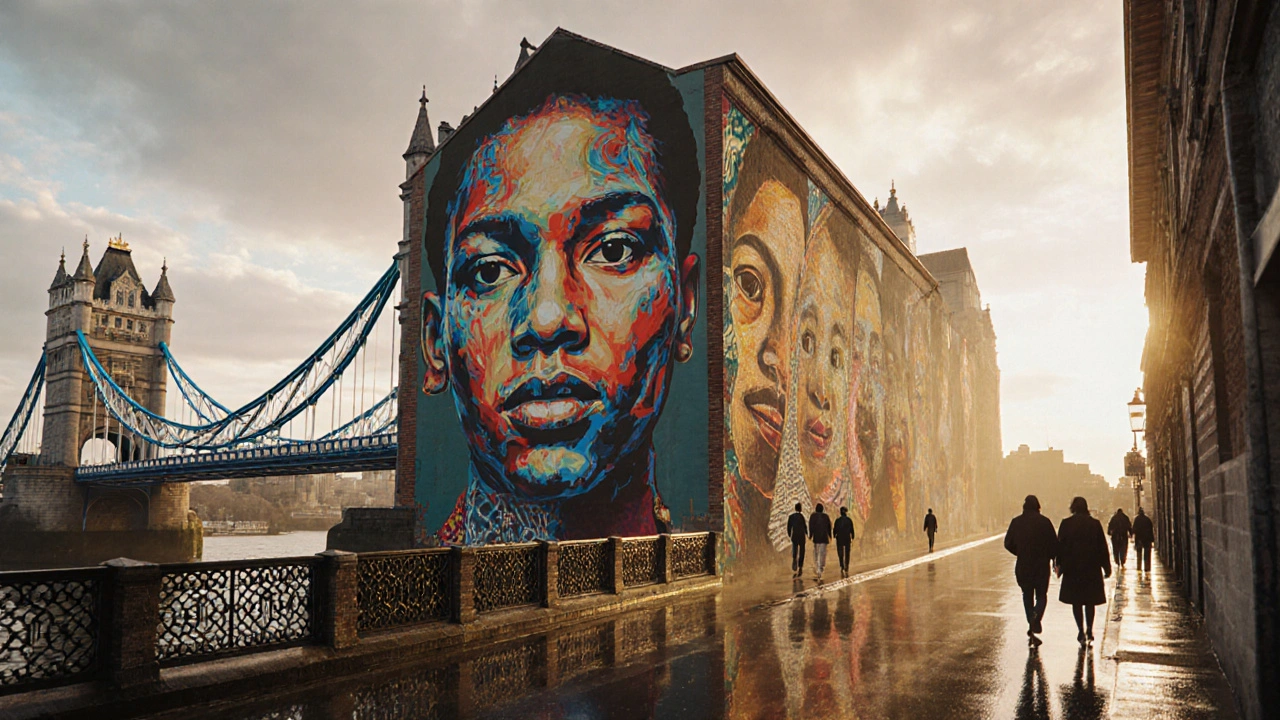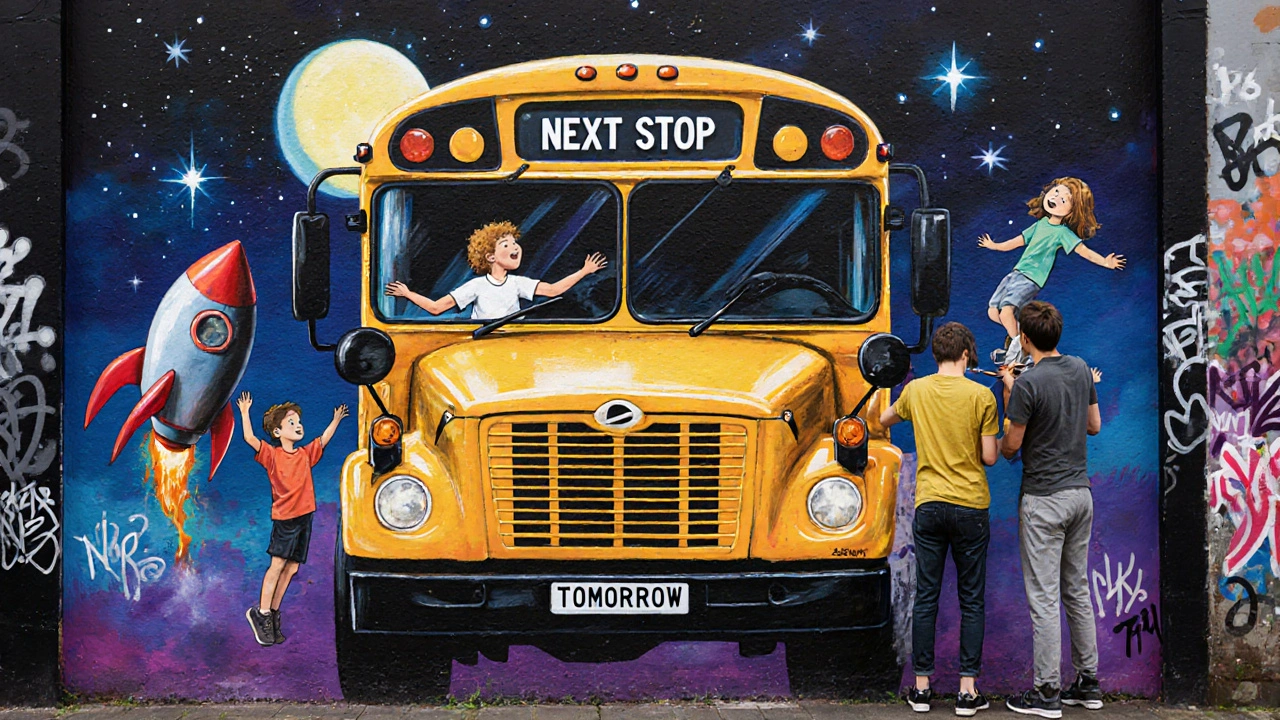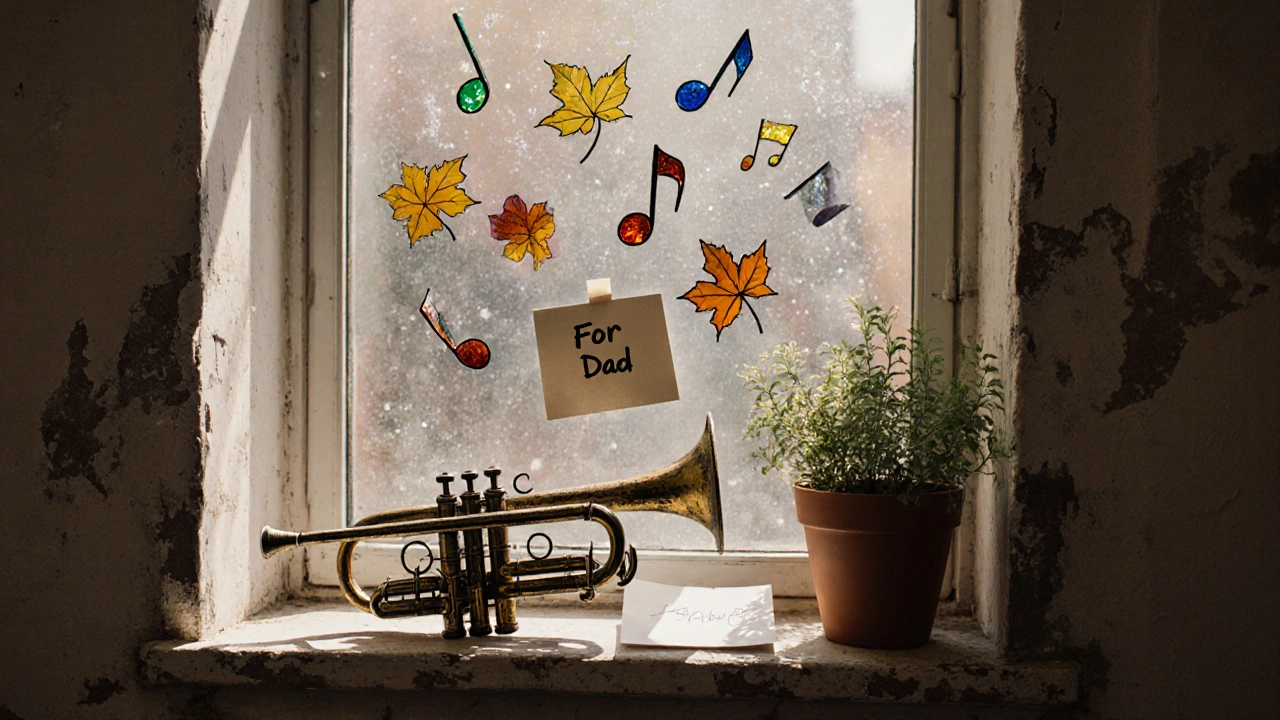
Every autumn, London turns into an open-air gallery. This year, the London Mural Festival brought more than 100 new murals to the city’s walls - each one painted by artists from over 20 countries. From Peckham’s alleyways to the underpasses of Hackney, the city is now a living canvas. You don’t need a ticket. You just need to walk out your door.
Where the Murals Are Hiding
The festival doesn’t have one central location. That’s the point. Murals popped up in places you’d never expect: beside a laundromat in Brixton, on the side of a boarded-up shop in Tottenham, even on the back of a bus depot in New Cross. Some are huge - 30 feet tall, stretching across entire building facades. Others are small, quiet, tucked between fire escapes. You’ll find them by accident, which is how street art was meant to be discovered.
One standout is Whispers of the Thames by Nigerian-British artist Kemi Ojo. It’s on a wall near Tower Bridge, showing layered faces of migrants who crossed the river in the last 50 years. Each face is painted in a different textile pattern from their home country - kente cloth, batik, embroidery. It’s not just a mural. It’s a history lesson you can’t ignore.
Who’s Painting These Walls?
The artists aren’t just famous names. Many are local. A 19-year-old from Croydon, Jayla Mendez, painted her first mural on a council garage wall in Southwark. It’s a portrait of her grandmother, holding a plant grown from seeds brought from Jamaica. The paint is still drying when you stand there. You can feel the care in every brushstroke.
International artists came too. From Brazil, Diego Ramos painted a giant serpent winding up a building in Shoreditch, its scales made of recycled metal scraps collected from East London junkyards. In Berlin, Lina Vogt brought her signature style - surreal, floating children holding balloons made of clouds. Her mural in Camden is already tagged with sticky notes from visitors: “This made me cry,” “I wish I could live here.”
What’s new this year? More women. More young artists. More collaboration. For the first time, the festival paired local teens with professional muralists. Over six weeks, they co-created 18 pieces. One group in Walthamstow painted a mural of a school bus turned into a rocket, with kids floating toward the moon. The bus’s license plate reads: “Next Stop: Tomorrow.”
Why This Festival Matters
Street art isn’t just decoration. It’s a response. After years of empty storefronts, rising rents, and quiet streets, London needed color. It needed voice. Murals don’t ask for permission. They just appear. And suddenly, a forgotten corner becomes a landmark.
A 2024 study by the London School of Economics found that neighborhoods with public murals saw a 22% increase in foot traffic within three months. Local shops reported higher sales. People took photos. They stayed longer. They talked to each other. One café owner in Dalston told me, “I used to have three customers a day. Now I’m busy by 9 a.m. because people come for the mural and stay for the coffee.”
It’s not just economic. It’s emotional. In areas with high youth unemployment, mural projects became alternatives to crime. In Tower Hamlets, a former gang member now leads a youth mural team. He told me, “I used to tag walls to be seen. Now I paint to be remembered.”

How to Find Them All
You won’t find a single map that shows every mural. That’s intentional. But here’s how to hunt them down:
- Start in Peckham. The Rye Lane area has 17 new pieces - including a giant hummingbird made of broken mirrors by artist Nia Johnson.
- Walk along the Regent’s Canal from Camden to Little Venice. Look up. Look down. Murals are on bridges, locks, and warehouse walls.
- Check Instagram hashtags: #LondonMuralFestival2025 and #LMF2025. Artists tag their locations. Real-time updates come from locals.
- Visit the free pop-up gallery at the Old Truman Brewery. It’s not the murals themselves, but sketches, interviews, and time-lapse videos of how each one was made.
Bring comfortable shoes. A water bottle. And your phone camera. Don’t just take a picture - stand in front of the mural. Let it hold your attention for a minute. Some of them change how you see the city.
What’s Different This Year
Last year, the festival was mostly commissioned work. This year, 60% of the murals were requested by residents. A grandmother in Islington asked for a mural of her late husband’s favorite jazz trumpet. A group of schoolkids in Lewisham wanted a mural of their class pet rabbit, now gone. The festival didn’t say no.
There’s also more sustainability. Paints are water-based and non-toxic. Brushes are recycled. The festival partnered with a local eco-studio that repurposes leftover paint into new colors. One mural in Greenwich used only paint made from crushed brick, chalk, and coffee grounds.
And for the first time, every mural has a QR code. Scan it, and you hear the artist’s voice explaining why they painted it. One artist from Nigeria said, “I didn’t come to London to be seen. I came to be heard.”

What Happens After the Festival?
The murals aren’t temporary. They’re protected. The city has a new policy: any mural painted under the festival is now part of the public art registry. That means it can’t be painted over without approval. Some are already being included in school tours. Others are being mapped by heritage groups.
There’s still damage. Graffiti tags appear. One mural in Barking was defaced within days. But the community responded. A local art group held a “Restore Day.” Over 80 people showed up with brushes, paint, and stories. They didn’t just fix the wall. They turned it into a community event.
The festival didn’t end on November 10. It just changed shape. Now, the murals are part of London’s rhythm. People know where to go. Tourists ask for them. Locals point them out. The city didn’t just get new art. It got new conversations.
Final Thought
You don’t have to be an art lover to feel this. You just have to walk outside. Look up. See the colors. Read the stories. One mural in Deptford shows a child holding a sign that says: “This is mine too.” It’s not just a message. It’s a promise.
Is the London Mural Festival free to visit?
Yes, absolutely. All murals are outdoors and publicly accessible. There are no tickets, no entry fees, and no restricted areas. You can walk, bike, or take public transport to see them anytime, day or night. The only cost is your time.
When does the London Mural Festival take place each year?
The festival runs every October and early November, with most murals completed by mid-November. The official launch weekend is the second weekend of October, but painting continues through the month. By late November, all pieces are finished and open for viewing.
Can I commission a mural for my building?
Yes. The festival accepts public requests each spring. Residents, businesses, and community groups can apply through the official website. If selected, the festival covers all materials and connects you with an artist. You’re responsible for wall access and basic prep - like cleaning and priming. Most applications are approved if the wall is visible, safe, and publicly accessible.
Are the murals protected from vandalism?
Yes. Since 2024, all festival murals are registered with the London Public Art Registry. This gives them legal protection against unauthorized removal or covering. Local councils work with community patrols to monitor high-risk areas. If a mural is damaged, the festival funds restoration within 30 days.
Do the artists get paid?
Yes. Each artist receives a stipend of £1,500 to cover materials and time. For international artists, travel and accommodation are also covered. The festival doesn’t pay for large-scale commercial commissions - only community-driven, non-advertising art. No logos, no brands, no sponsored content allowed.
How do I know if a mural is part of the festival?
Look for a small, discreet plaque near the bottom of the mural - usually metal or ceramic. It says “London Mural Festival 2025” and includes a QR code. Some murals also have a tiny logo: a brushstroke inside a circle. If you see that, it’s official. If not, it’s just street art - still beautiful, just not part of the festival.